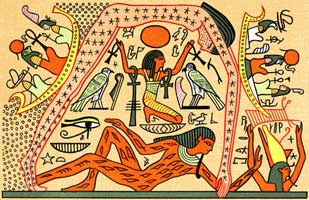 Heqet was a popular goddess
depicted as a frog who bore the title "She who hastens the birth". She gave
breath to the fetus at the last moment of birth, and later became associated
with resurrection through the Osiris myth.
As the animal form of deities, frogs were sacred, and it was forbidden to kill
one. Ancient frog statuettes bear the hieroglyphs for Heqet, and are still sold today.
Heqet was a popular goddess
depicted as a frog who bore the title "She who hastens the birth". She gave
breath to the fetus at the last moment of birth, and later became associated
with resurrection through the Osiris myth.
As the animal form of deities, frogs were sacred, and it was forbidden to kill
one. Ancient frog statuettes bear the hieroglyphs for Heqet, and are still sold today.
But now, the frogs were a literal source of uncleaness as well as typifying it as in Revelation 16:13.
"Ironically, the frogs infested the bedrooms and beds of the Egyptians; the very places where the blessings of Heqet were sought. It is somewhat amusing to picture the people of Egypt attempting to gingerly step over these millions of frogs as they walked about, afraid to crush any of these sacred animals beneath their feet. [Answers From the Book]"
 Unlike the Caananite religion, the earth god of Egypt was
male: the great Geb, who longed for his sister Nut, the sky goddess, but was
forever separated from her by Shu (god of the wind and air). He was pictured
lying on his back looking at Nut, with his knees at different heights
suggesting mountains or hills. But now, as in Genesis, the dust of the earth
was made a curse - on the Hebrews and the Egyptians alike.
Unlike the Caananite religion, the earth god of Egypt was
male: the great Geb, who longed for his sister Nut, the sky goddess, but was
forever separated from her by Shu (god of the wind and air). He was pictured
lying on his back looking at Nut, with his knees at different heights
suggesting mountains or hills. But now, as in Genesis, the dust of the earth
was made a curse - on the Hebrews and the Egyptians alike.